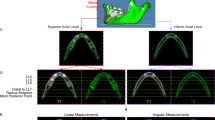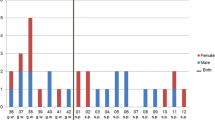Abstract
Purpose
The mandibular canal contributes to the development and growth of the mandible, as it acts as a conduit for the growing inferior alveolar neurovascular structures. A clear understanding of the canal’s pathway is, therefore, important in interpreting the growth pattern of the inferior alveolar neurovascular bundle. This study investigated the position of the mandibular canal within the body of the mandible and its general dimensions within a pediatric collection of mandibles.
Methods
The sample included 45 mandibles and was subdivided into three: group 1 (30 gestational weeks to birth), group 2 (birth to 12 months), and group 3 (1 to 4 years). Mandibles were scanned using a Nikon XTH 225L micro-CT unit. Scanning conditions ranged between 85 kV/83 µA and 100 kV/100 µA. Measurements included: the maximum width and height of the mandibular canal and distances between the mandibular canal and the relevant surfaces of the mandible. Data analysis included an ANOVA, MANOVA, and principal component analysis.
Results
The mandibular canal increased significantly in size from 30 gestational weeks to 12 months relative to the deciduous molar crypts. Postnatally, the mandibular canal increased significantly in height at the level of the second deciduous molar crypt. The canal lies closer to the buccal surface in the region of the first and second deciduous molar teeth.
Conclusion
The consistency in the positioning of the mandibular canal within the body of the mandible may assist in predicting the occurrence of aberrant growth patterns, particularly during the initial stages of growth.



Similar content being viewed by others
References
Allan JC (1982) Learning about statistics: a primer in simple statistical methods for students of the medical, biological, paramedical, social and behavioural sciences, 1st edn. Macmillan South Africa, Johannesburg
AlQahtani SJ, Hector MP, Liversidge HM (2010) Brief communication: the London atlas of human tooth development and eruption. Am J Phys Anthropol 142:481–490
Bjork A (1969) Prediction of mandibular growth rotation. Am J Orthod 55:585–599
Celikoglu M, Bayram M, Nur M (2011) Patterns of third-molar agenesis and associated dental anomalies in an orthodontic population. Am J Orthod Dentofac Orthop 140:856–860
Chavez-Lomeli ME, Mansilla Lory J, Kjaer I (1996) The human mandibular canal arises from three separate canals innervating different tooth groups. J Dent Res 75:1540–1544
De Oliveira-Santos C, Souza PHC, de Azambuja Berti-Couto S, Stinkens L, Moyaert K, Fischer Rubira-Bullen IR, Jacobs R (2012) Assessment of variations of the mandibular canal through cone beam computed tomography. Clin Oral Invest 16:387–393
Hammer O, Harper DAT, Ryan PD (2001) PAST: paleontological statistics software package for education and data analysis. Palaeontol Electron 4:9
Hazarey PV, Hazarey A, Babbar K, Kharche A, Chachada A (2015) Assessment of position of mandibular canal in relation to mandibular plane in different growth patterns. J Pierre Fauchard Acad (India Sect) 29:32–35
Herring SW (1985) The ontogeny of mammalian mastication. Am Zool 25:339–349
Hutchinson EF, Kieser JA, Kramer B (2014) Morphometric growth relationships of the immature human mandible and tongue. Eur J Oral Sci 122:181–189
Jungers WL, Falsetti AB, Wall CE (1995) Shape, relative size and size adjustments in morphometrics. Am J Phys Anthropol 38:137–161
Kettunen P, Loes S, Furmanek T, Fjeld K, Kvinnsland IH, Behar O, Yagi T, Fujisawa H, Vainio S, Taniguchi M, Luukko K (2005) Coordination of trigeminal axon navigation and patterning with tooth organ formation: epithelial-mesenchymal interactions, and epithelial Wnt4 and Tgfbeta1 regulate semaphoring 3a expression in the dental mesenchyme. Development 132:323–334
Kilic C, Kamburoglu K, Ozen T, Balcioglu HA, Kurt B, Kutoglu T, Ozan H (2010) The position of the mandibular canal and histologic feature of the inferior alveolar nerve. Clin Anat 23:34–42
Kjaer I (1997) Can the location of tooth agenesis and the location of initial bone loss seen in juvenile periodontitis be explained by neural developmental fields in the jaws? Acta Odontol Scand 55:70–72
Kjaer I, Kocsis G, Nodal M, Christensen LR (1994) Aetiological aspects of mandibular tooth agenesis—focusing on the role of nerve, oral mucosa and supporting tissues. Eur J Orthod 16:371–375
Lee SK, Kim YS, Oh HS, Yang KH, Kim EC, Chi JG (2001) Prenatal development of the human mandible. Anat Rec 263:314–325
Littner MM, Kaffe I, Tamse A, Dicapua P (1991) Relationship between the apices of the lower molars and mandibular canal—a radiographic study. Oral Surg Oral Med Oral Pathol 62:595–602
Lumsden AGS, Buchanan JAG (1986) An experimental study of timing and topography of early tooth development in the mouse embryo with an analysis of the role of innervation. Arch Oral Biol 31:301–311
Luuko K, Kettunen P (2014) Coordination of tooth morphogenesis and neuronal development through tissue interactions: lessons from mouse models. Exp Cell Res 325:72–77
Luukko K, Arumae U, Karavanov A, Moshnyakov M, Sainio K, Sariola H, Saarma M, Thesleff I (1997) Neurotrophin mRNA expression in the developing tooth suggests multiple roles in innervation and organogenesis. Dev Dyn 210:117–129
Luukko K, Moshnyakov M, Sainio K, Saarma M, Sariola H, Thesleff I (1996) Expression of neurotrophin receptors during rat tooth development is developmentally regulate, independent f innervation, and suggests functions in the regulation of morphogenesis and innervation. Dev Dyn 206:87–99
Mosimann JE (1970) Size allometry: size and shape variables with characterizations of the lognormal and generalized gamma distributions. J Am Stat Assoc 65:930–945
Moss ML (1960) Functional analysis of human mandibular growth. J Pros Den 10:1149–1159
Moss ML (1962) The functional matrix. Vistas Orthod 85–98
Moss ML, Salentijn L (1969) The primary role of functional matrices in facial growth. Am J Orthod 55:566–577
Pearson AA (1977) The early innervation of the developing deciduous dentition. J Anat 123:563–577
Ricketts RM (1972) A principle of archial growth of the mandible. Angle Orthod 42:368–386
Shiozaki F, Fukami K, Kuribayashi A, Shimoda S, Kobayashi K (2014) Mandibular lingual canals distribute to the dental crypts in prenatal stage. Surg Radiol Anat 36:447–453
Tsakiris P, Kramer B, Lownie JF (1996) A radiographic analysis of the mandibular canal of the edentulous mandible in different racial and gender groups. J Dent Assoc S Afr 51:759–765
Yu SK, Lee MH, Jeon YH, Chung YY, Kim HJ (2015) Anatomical configuration of the inferior alveolar neurovascular bundle: a histomorphometric analysis. Surg Radiol Anat. doi:10.1007/s00276-015-1540-6
Acknowledgments
Mr Frikkie de Beer and Mr Lunga Bham of the South African Nuclear Energy Corporation are acknowledged for their use of the MIXRAD facilities. The authors would also like to acknowledge Drs. Kris Carlson and Tea Jashashvili of the Paleontological Sciences Institute, University of the Witwatersrand for use of computer facilities.
Author information
Authors and Affiliations
Corresponding author
Ethics declarations
Conflict of interest
The authors declare that they have no conflict of interest.
Rights and permissions
About this article
Cite this article
Hutchinson, E.F., Florentino, G., Hoffman, J. et al. Micro-CT assessment of changes in the morphology and position of the immature mandibular canal during early growth. Surg Radiol Anat 39, 185–194 (2017). https://doi.org/10.1007/s00276-016-1694-x
Received:
Accepted:
Published:
Issue Date:
DOI: https://doi.org/10.1007/s00276-016-1694-x




